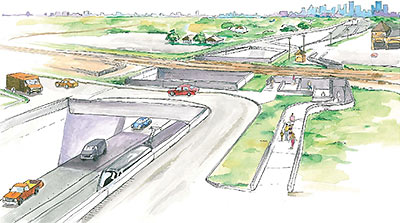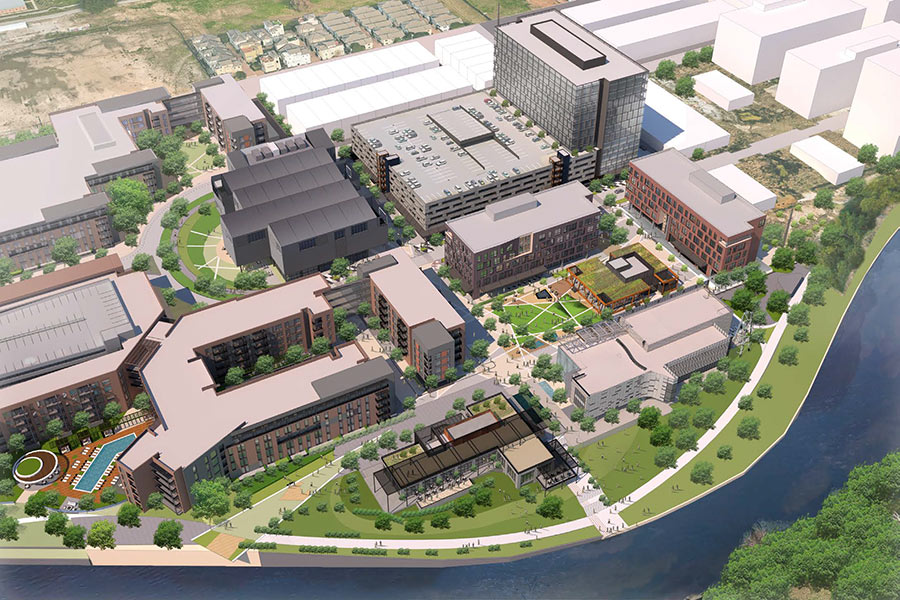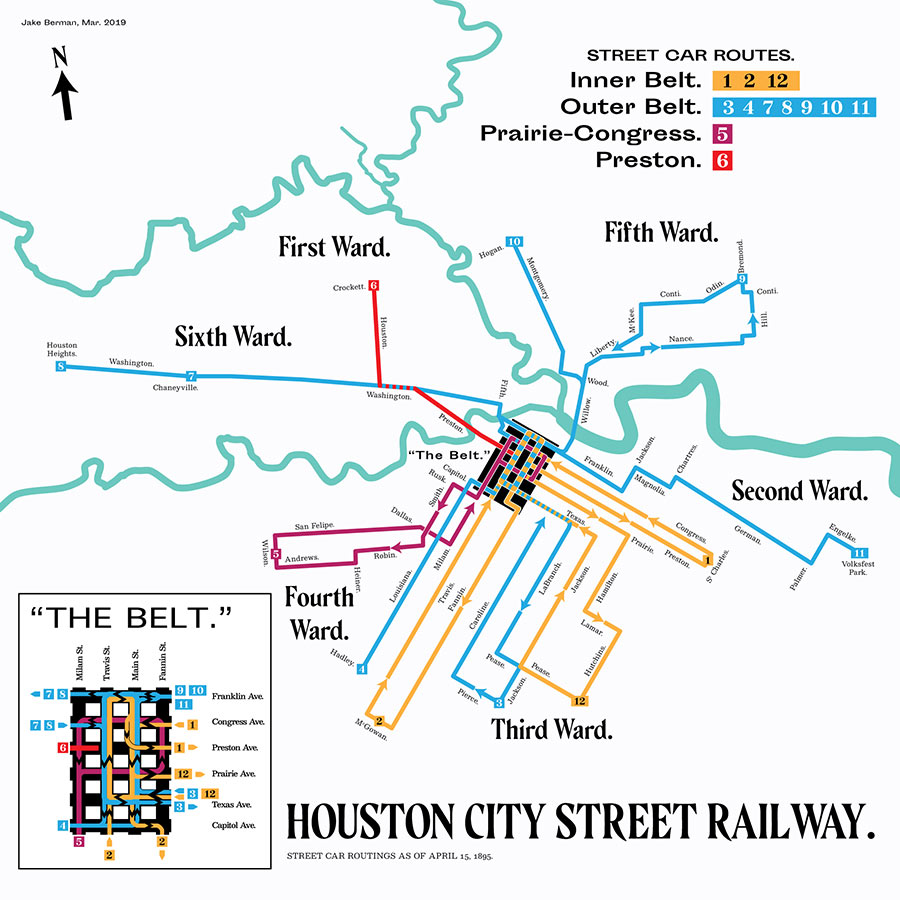
Harrisburg Blvd. and the East End light-rail line Metro is building along it will dip under the Union Pacific East Belt freight rail line between the future Altic and Cesar Chavez stations, Mayor Parker announced today. The city has committed $20.6 million of “existing money” to the build the underpass — in part by delaying other area improvement projects. The alternative, a longer freeway-style overpass, was opposed by many area residents and businesses.
- We have found the funding for an underpass and City of Houston has committed $20.6 million to put part of the East End Metro line underground. [Twitter]
- East End residents fight plan for Metro rail overpass [Houston Chronicle]
Drawing: City of Houston





I can’t help but think of a couple of the underpasses along I-45 adjacent to UH and what happens when it rains.
Another example of people who can and will speak up getting their way. This will add probably 2 yrs to the line completion but I believe that it’ll be worth the wait.
This underpass has been needed for a long time, even if it took the light rail to make it happen. There was no way that an overpass would work in that location.
The underpass was supported by the overwhelming majority of residents and businesses in the area, including every civic group from downtown to the ship channel. A few vocal residents speaking for themselves because of a perceived loss of jobs. Studies show that new development occurs with underpasses and a massive overpass would have killed businesses, lost jobs, and caused at best stagnation and most likely a drop in property values around the project. (Reference the smaller Navigation overpass a few blocks away.) The most vocal business has very few employees and the owner has a relationship with METRO. This will be a benefit to the greater community for decades to come.
good move.
Typical: the COH has to lay off employees, but can “find” 20.6 million to build a fricking underpass for a train with less riders than the “projections” suggest!!!!!!!!!!!!!
Worth noting: the previous plan only elevated the light rail line; so cars would still have been at ground level waiting for freight trains to pass. The new plan takes both cars and light rail under the tracks. So this is a big benefit for traffic flow (and emergency vehicles) in the East End.
I thought Metro had a policy against naming train stops after people. Why the exception for Cesar Chavez?
Really? Really? Spending all that money on a rail line when an electric powered bus can do the same damn thing. I don’t understand it. What advantages does a rail have over a bus? It takes away lanes, makes more traffic. I sometimes had ridden the rail, and the same people are on it that would take a bus. This is not time to spend all this money thatthe city does not have. and will put off other projects? Please somebody justify this for me.
Ben-
Cesar Chavez Blvd is the name of the cross street at the station location, so the station is named after the street, not the person. It’s like, say, McGowen station (though no one remembers Andrew McGowen). But that’s still a placeholder name — the final name of that station, like all the others on the new lines hasn’t been decided. Let us know what names you prefer at http://www.gometrorail.org/go/doc/2491/1132811/.
I hadn’t noticed that this moved cars below, too. That’s great news. If you think the crossings at Heights Blvd. or San Felipe / Westheimer / Richmond are inconvenient, you should experience how often trains shut down traffic in the East End. I guess this underpass will be like the one on the Main Street Line in the Med Center, rather than the freeway feeders on I-45. What happens on the Main Street Line underpass in average rain? Or the sunken portions of 59 for that matter?
I’d like to thank Christof for being the one board member of Metro(that I know of) that takes the time to interact with people on these issues and someone that practices what they preach by taking metro to places.
It’s a Cadillac grade separation for sure — but grade separations lost a long, long time. Others underpasses in the area are nearly 100 years old. That’s a long time to realize your bang for the buck. And it would be very unfortunate to build something that would in any way undermine our investment in quality light rail for that long. This is the best choice for the community, for the businesses, for future light rail riders, and for everyone else that has a stake in the East End. And with everything happening over here, I honestly believe that all of Houston will very soon have a stake.
More pandering to the whiny loudmouth minority.
No doubt these folk will whine and cry some more when this underpass fills with up with water when it rains.
This side of town already looks like you know what so this is a good move.
Plus when we run off all the loals with rising real estate prices it’ll help us investors.
I love the children’s storybook rendering – it looks like such a happy little intersection!
More pandering to the whiny loudmouth minority.
No doubt these folk will whine and cry some more when this underpass fills with up with water when it rains.
—-
Just think of the disruptions to the light rail system during the next Allison.
I’m torn between the quality of life benefit of the underpass and the adverse time/cost effects of this decision.
I appreciate Christof’s interaction with us here as well. Keep it up!
But I will beat this horse until the HSPCA comes and takes it away when I say that–Houston’s REAL and IMMEDIATE mass transit need is an east-west corridor through the densest and most-likely to use rail transit neighborhoods, i.e. the University line.
I wish we could table the other expansions, which IMO, provide the smallest benefit to most Houstonians–and instead get the University line built.
fortunately i no longer live off Richmond so i can now be a rail supporter. so yes, please spend my hard-earned tax dollars on subsidized transportation for the wealthiest zip codes and real estate owners in town.
however, i still think these trains suck. rails on the freeways supporting a bus spoke system is what we need. rail just seem delusional with houston’s ridership numbers/density on streets.
bobby, just read your last sentence and can’t say i agree. while agree that the east-west corridor is denser it’s also already well supported by a bus system that could use a lot more daily riders.
i thought one of the big pushes for these rail lines was redevelpment though. the city isn’t going to get the same scale of revenue from new development/real estate values on Richmond as they’ll get elsewhere. It’s already highly valued land and the rail won’t affect it as much The Richmond line will cost a lot more, require more city money and more land grabs. However, development along Richmond has been and will always be stunted until they finally do put this rail in so we’re pretty much stuck at this point.
It may be great for a lot of folks, but it’ll cost taxpayers a lot more and i highly doubt the cost/benefit ratio for the millions of folks that will never ride these will better than the east end lines are.
At this particular point in time I cringe at hearing the COH uses terms like “existing money” o the tune of $20.6M when just this week a COH garbage truck hit my car in my driveway. The dickhead city official is telling me their process takes 60-90 days to get approval to pay for their liable accident their employees caused on my property. Damn it feels good to be taxpayer!!!!!!
@markd – I didn’t realize that you attended every impacted neighborhood’s meetings, the meetings with Metro and the City, and took a poll of all of the citizens in the area. Perhaps you’d like to share your research data with the rest of us.
In other words: when you say that “a whiny minority” wanted the underpass, I respond with [citation needed].
I’m glad to see COH spending money on forgotten areas of Houston.
Good decision. Spend the money on something that will benefit the entire community. What a novel idea.
“it’s also already well supported by a bus system that could use a lot more daily riders.”
Whereas a lot of people make the argument that light rail attracts riders that wouldn’t normally ride the bus–that “rail WOW factor”, and I think are rightly derided for their overly optimistic ridership projections… I think the success of the existing Red line in terms of daily boardings/mile of track and annual ridership, especially in comparison to established rail transit cities makes the case that people in Houston ride the rails. So I think the case of the 65/25/81/82 bus corridors doesn’t really enter into the debate on an east/west rail corridor.
If we are to consider the Metrorail expansion as primarily a redevelopment project, then I think that it’s probably one of the most inefficient and squandering ways to accomplish that end. I nevertheless raise the point that developers typically view rail as an amenity and rush to redevelop those areas–even if land prices are higher (especially given that the neighborhoods along the Blue line have higher density, higher wealth, and a disproportinately higher concentration of students).
I don’t think though, that METRO views itself primarily as a neighborhood development entity (we have the TIRZs for that), and so, given that an agency like METRO is an unprofitable subsidy for the greater public good (much like the Postal Service), it’s more important to consider where we could realize the greatest potential mobility gains and my biggest beef with the whole handling of the Metro Solutions Phase II plan is that they’re not doing a very good job of that–the poster child of which is the University line.
The University line is the lynchpin which roots Houston’s light rail system as exactly that–a system. The extensions to the north on the Red line and the downtown circulator service provided by the east end/southeast lines, are sickly appendages without the East/West corridor which links all of Houston’s primary business/arts/education/recreation and population centers.
When I think about this $20.6 million pet project, which according to an earlier METRO study, could cost anywhere between $22 and 31 million more, I can only help but feel disappointed at the attention and resources being given to the east end line when our priorities ought to be elsewhere.
The FTA RoD has been in for some time, yet there has been no word on when/how this line will move forward ever since the New Starts $900M grant fiasco….
Uptown Houston represents approximately 12 percent of Houston’s total office space, making it second in size to Downtown Houston, the 17th largest business center in the U.S. and compares in size to the downtowns of Seattle and Denver.
Uptown Park’s Annual revenue from retail sales taxes generated in Uptown Houston totals approximately $150 million. Its retail establishments contribute more than $18 million annually to METRO.
; http://www.uptown-houston.com/about/facts.html.
Metro is ignoring the University & Uptown lines; robbing the rich and giving it to the poor and the less populated area of Houston. Wise decision? NOPE!
Maybe we should all go shop at Katy, Cypress’s Houston Premium Outlets or in Sugar Land. After all METRO is ignoring the University and the Uptown Line and using the money somewhere else. Not wise METRO!
I’m puzzled by a lot of the comments here. Are people unaware that Harrisburg already goes under the railroads at that intersection? It works fine, even in the rain. If you live over here you can see how the obvious choice is for the rail to do the same thing the street already does.
#26 @ David
Now I’m confused. What intersection do you mean?
That’s a pretty rendering, but they forgot to add the graffiti and urine stains.
On the other hand, the Union Pacific Railroad will be glad to get rid of a busy grade crossing.
David #26 is somewhat right, and somewhat wrong. Harrisburg has an existing underpass *at the railroads immediately east of US 59*, and that doesn’t flood that I’m aware of.
This new underpass will also be on Harrisburg, but further east, between Lockwood and Wayside, where there currently is an at-grade crossing.
Thanks Dave, I forgot about that one nearer to town. I thought maybe he meant the Wayside/Capitol underpass near the golf course. Course it’s a block or two off Harrisburg.
Houston Chronicle, Wednesday, July 27, 2011 by Carol Christian reports that “Underpass to cost city $20.6 million” :- “Finding the money to fund the underpass had been a struggle but the solution of freeing up part of the money by postponing Metro’s two street and drainage projects to help fund it.
The total expected cost of the underpass is about $43 million – about $23 million more than an overpass.
THE EAST END LINE IS NOT FEDERALLY FUNDED.”
Something is VERY wrong with the picture. If Metro does not have the money why build it?
I see this comment a lot on here: “What can rail do that a bus can’t?”
Well, if you really need to ask this question, you obviously haven’t ridden both bus systems and rail systems, and should probably educate yourselves on transportation (do some research).
Rail:
-Carries MORE people than a bus line.
-Is more reliable than a bus line.
-Has a cheaper and more efficient operating cost than a bus line.
-Attracts more riders than a bus, due to its speed, reliability, and capacity.
Conclusion: If you want Houston’s transit system to have more ridership, the most effective way to increase riderhsip is to build a core rail system. This has been shown in plenty of other cities, if you care to do your own research.
Now for the topic:
I think the underpass is a good idea, however I wish METRO would have figured this out earlier. Changing plans mid-construction is never a good idea. It ends up costing more, and delays the project. But, I have to concede that this plans is better than the previous overpass plan, and is a better fit IMO.